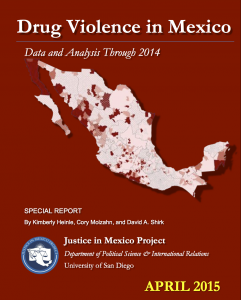
10/05/16 (written by kheinle) — A report released in late August by the Hoover Institution at Stanford University provides an in depth look at security strategies in Mexico, an important contribution to the ongoing conversation about a country embroiled in crime and violence for years. In “Security Strategies: Experiences Of The Mexican States Of Chihuahua And Nuevo León,” co-authors Arturo Ramírez Verdugo and Reyes Ruiz González found that the state and local policies implemented in Mexico to combat insecurity related to drug trafficking organizations (DTO) have been more effective than efforts taken at the national level.
The report focuses on case studies in Chihuahua and Nuevo León, two states on the U.S.-Mexico border that have been hotspots for drug trafficking, crime, and violence. Chihuahua and Nuevo León have had some of the highest levels of ejecuciones, homicides related to organized crime, since 2007 when former President Felipe Calderón (2006-2012) launched the nationwide campaign against drug trafficking and related violence. The Hoover Institute report examines both states’ administrative policies implemented to reduce levels of violence, which resulted in clear decreases in Chihuahua’s and Nuevo León’s homicide rates, kidnapping rates, and the number of vehicle thefts from their peak in 2010-2011.
Overall, the public’s perception of state insecurity, and the absolute number of victims and crimes in both states declined between 2010 and 2014. Specifically in Chihuahua, for example, homicide rates per 100,000 inhabitants declined from 111 to 30 between 2010 to 2014, and from 7 to 0 inhabitants per 100,000 for kidnapping rates between 2009 and 2014. Similarly, Nuevo León saw homicide rates peak at 42 per 100,000 in 2011 and decline quickly to 10 per 100,000 in 2014, though the state’s kidnapping rates did not begin declining until 2012, decreasing from 1.25 to 0.80 by 2014. Extortion rates also declined in Chihuahua, although they increased steadily in Nuevo León from 1 per 100,000 inhabitants in 2008 to 8 per 100,000 in 2014. That said, the cifra negra (black number, or the number of unreported or uninvestigated crimes) decreased in Nuevo León during this time period, but increased in Chihuahua, an interesting finding considering that state’s otherwise positive strides in other areas.
 The authors drew from Justice in Mexico’s research as a primary source of information, specifically from “Drug Violence in Mexico: Data and Analysis Through 2014” released in April 2015. That publication is part of a series Justice in Mexico releases annually that compiles and analyzes the latest available data on crime and violence in Mexico as it relates to organized crime. The Drug Violence in Mexico series seek to inform a U.S. and English language audience, as international news media coverage of Mexico tends to be fleeting and gravitates toward sporadic sensationalistic incidents rather than the analysis of broader issues and longer-term trends. Justice in Mexico’s latest such report can be found here.
The authors drew from Justice in Mexico’s research as a primary source of information, specifically from “Drug Violence in Mexico: Data and Analysis Through 2014” released in April 2015. That publication is part of a series Justice in Mexico releases annually that compiles and analyzes the latest available data on crime and violence in Mexico as it relates to organized crime. The Drug Violence in Mexico series seek to inform a U.S. and English language audience, as international news media coverage of Mexico tends to be fleeting and gravitates toward sporadic sensationalistic incidents rather than the analysis of broader issues and longer-term trends. Justice in Mexico’s latest such report can be found here.
The Hoover Institute also relied on data from Mexico’s Executive Secretariat of the National System of Public Security (Secretariado Ejecutivo del Sistema Nacional de Seguridad Pública, SESNSP), the National Institute of Statistics and Geography (Instituto Nacional de Estadística y Geografía, INEGI), the National Population Council (Consejo Nacional de Población, CONAPO), and the National Survey of Victimization and Perception about Public Security (Encuesa Nacional de Victimización y Percepción sobre Seguridad Pública, ENVIPE), among others.
In the end, Ramírez Verdugo and Ruiz González found that strategies were most effective when several factors are incorporated into security strategies. First, “the state’s actions have a multiplicative effect when the civil society is involved.” Second, local law enforcement institutions must be strengthened, while, third, new procedural common law must be reformed. Next, convicted criminals must be better reinserted into society so to address recidivism and repeat offenders. Lastly, “strategies require a true commitment to fiscal discipline from [Mexican] states to make [them] viable and sustainable.” As Ramírez Verdugo and Ruiz González argue, Chihuahua and Nuevo León demonstrate that the rule of law can be improved when following strategies that prioritize and incorporate these factors.
Sources:




